Comprehensive Report: Lake Michigan Ecosystem Dynamics and Challenges
VerifiedAdded on 2021/05/31
|6
|1263
|66
Report
AI Summary
This report provides an in-depth analysis of the Lake Michigan ecosystem, highlighting its unique characteristics as a deep-water oligotrophic environment. It explores the interplay of biotic and abiotic factors, including depth, temperature, and the impact of invasive species like zebra mussels. The report emphasizes the ongoing transitions within the food web, driven by factors such as nutrient abatement programs and the introduction of invasive species at various trophic levels. It discusses the role of invasive species, particularly dreissenid mussels, and their impact on the ecosystem, including trophic cascades and changes in biodiversity. The report also addresses the need for further ecological research to understand and predict the ecosystem's response to stresses like climate change and fishery management. Various references are also included to support the analysis.
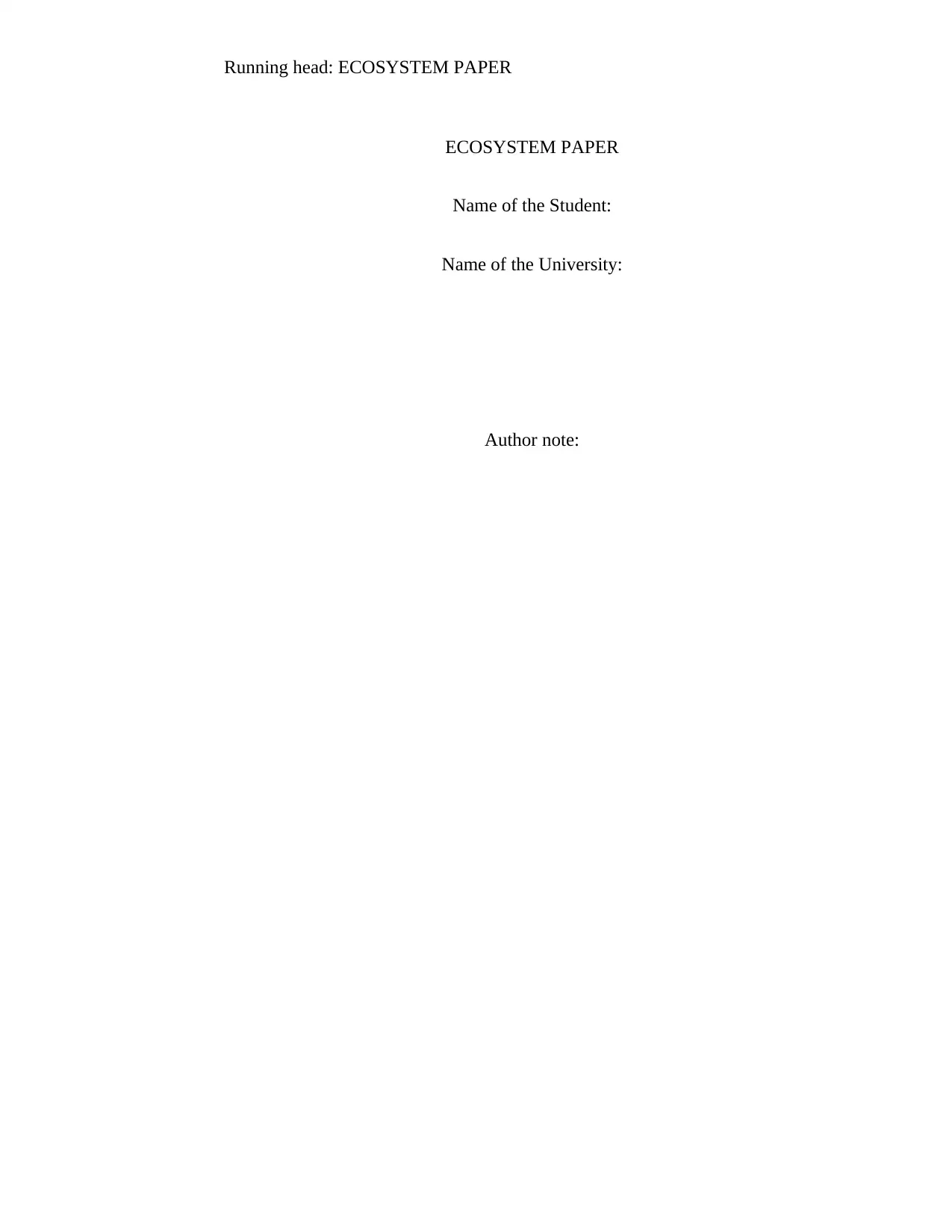
Running head: ECOSYSTEM PAPER
ECOSYSTEM PAPER
Name of the Student:
Name of the University:
Author note:
ECOSYSTEM PAPER
Name of the Student:
Name of the University:
Author note:
Paraphrase This Document
Need a fresh take? Get an instant paraphrase of this document with our AI Paraphraser
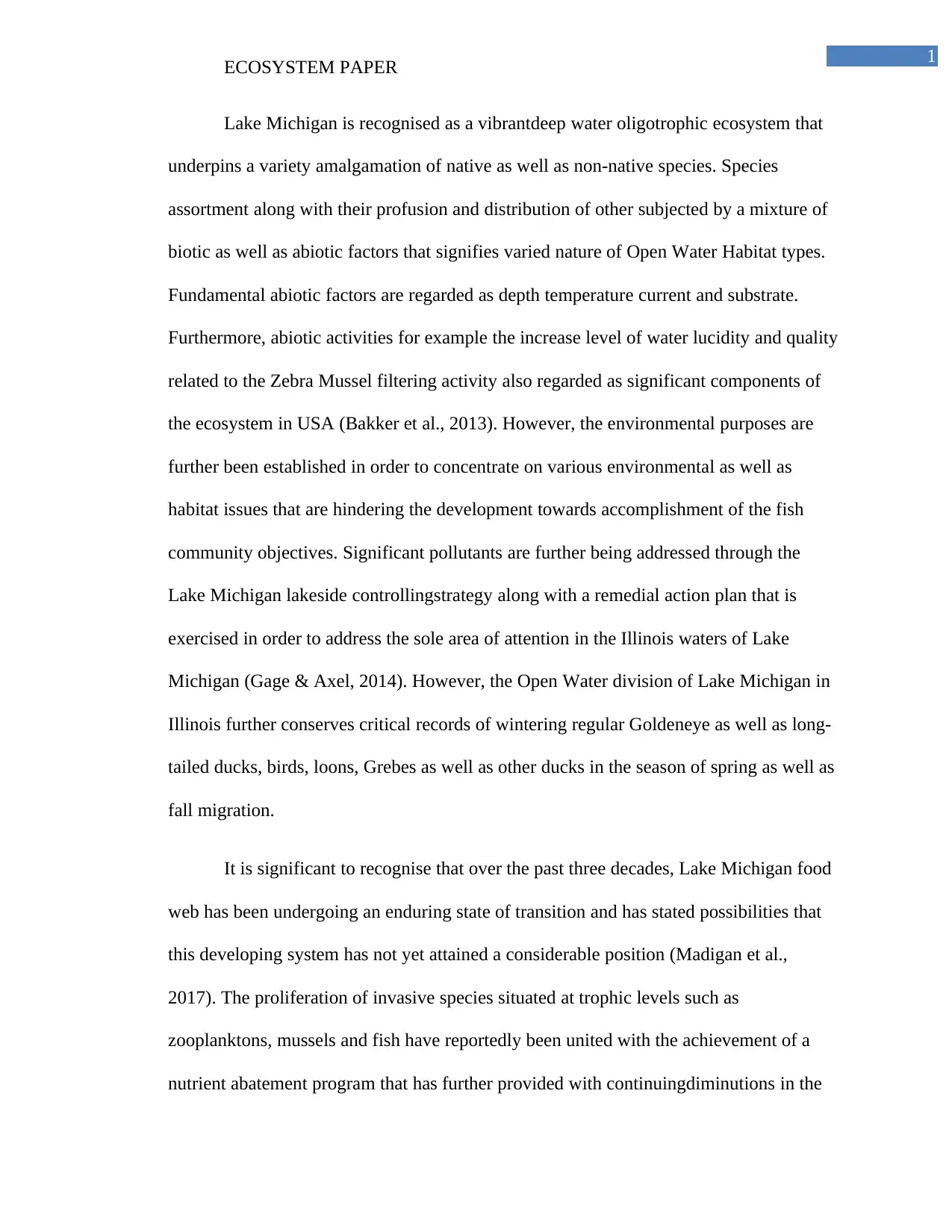
1
ECOSYSTEM PAPER
Lake Michigan is recognised as a vibrantdeep water oligotrophic ecosystem that
underpins a variety amalgamation of native as well as non-native species. Species
assortment along with their profusion and distribution of other subjected by a mixture of
biotic as well as abiotic factors that signifies varied nature of Open Water Habitat types.
Fundamental abiotic factors are regarded as depth temperature current and substrate.
Furthermore, abiotic activities for example the increase level of water lucidity and quality
related to the Zebra Mussel filtering activity also regarded as significant components of
the ecosystem in USA (Bakker et al., 2013). However, the environmental purposes are
further been established in order to concentrate on various environmental as well as
habitat issues that are hindering the development towards accomplishment of the fish
community objectives. Significant pollutants are further being addressed through the
Lake Michigan lakeside controllingstrategy along with a remedial action plan that is
exercised in order to address the sole area of attention in the Illinois waters of Lake
Michigan (Gage & Axel, 2014). However, the Open Water division of Lake Michigan in
Illinois further conserves critical records of wintering regular Goldeneye as well as long-
tailed ducks, birds, loons, Grebes as well as other ducks in the season of spring as well as
fall migration.
It is significant to recognise that over the past three decades, Lake Michigan food
web has been undergoing an enduring state of transition and has stated possibilities that
this developing system has not yet attained a considerable position (Madigan et al.,
2017). The proliferation of invasive species situated at trophic levels such as
zooplanktons, mussels and fish have reportedly been united with the achievement of a
nutrient abatement program that has further provided with continuingdiminutions in the
ECOSYSTEM PAPER
Lake Michigan is recognised as a vibrantdeep water oligotrophic ecosystem that
underpins a variety amalgamation of native as well as non-native species. Species
assortment along with their profusion and distribution of other subjected by a mixture of
biotic as well as abiotic factors that signifies varied nature of Open Water Habitat types.
Fundamental abiotic factors are regarded as depth temperature current and substrate.
Furthermore, abiotic activities for example the increase level of water lucidity and quality
related to the Zebra Mussel filtering activity also regarded as significant components of
the ecosystem in USA (Bakker et al., 2013). However, the environmental purposes are
further been established in order to concentrate on various environmental as well as
habitat issues that are hindering the development towards accomplishment of the fish
community objectives. Significant pollutants are further being addressed through the
Lake Michigan lakeside controllingstrategy along with a remedial action plan that is
exercised in order to address the sole area of attention in the Illinois waters of Lake
Michigan (Gage & Axel, 2014). However, the Open Water division of Lake Michigan in
Illinois further conserves critical records of wintering regular Goldeneye as well as long-
tailed ducks, birds, loons, Grebes as well as other ducks in the season of spring as well as
fall migration.
It is significant to recognise that over the past three decades, Lake Michigan food
web has been undergoing an enduring state of transition and has stated possibilities that
this developing system has not yet attained a considerable position (Madigan et al.,
2017). The proliferation of invasive species situated at trophic levels such as
zooplanktons, mussels and fish have reportedly been united with the achievement of a
nutrient abatement program that has further provided with continuingdiminutions in the
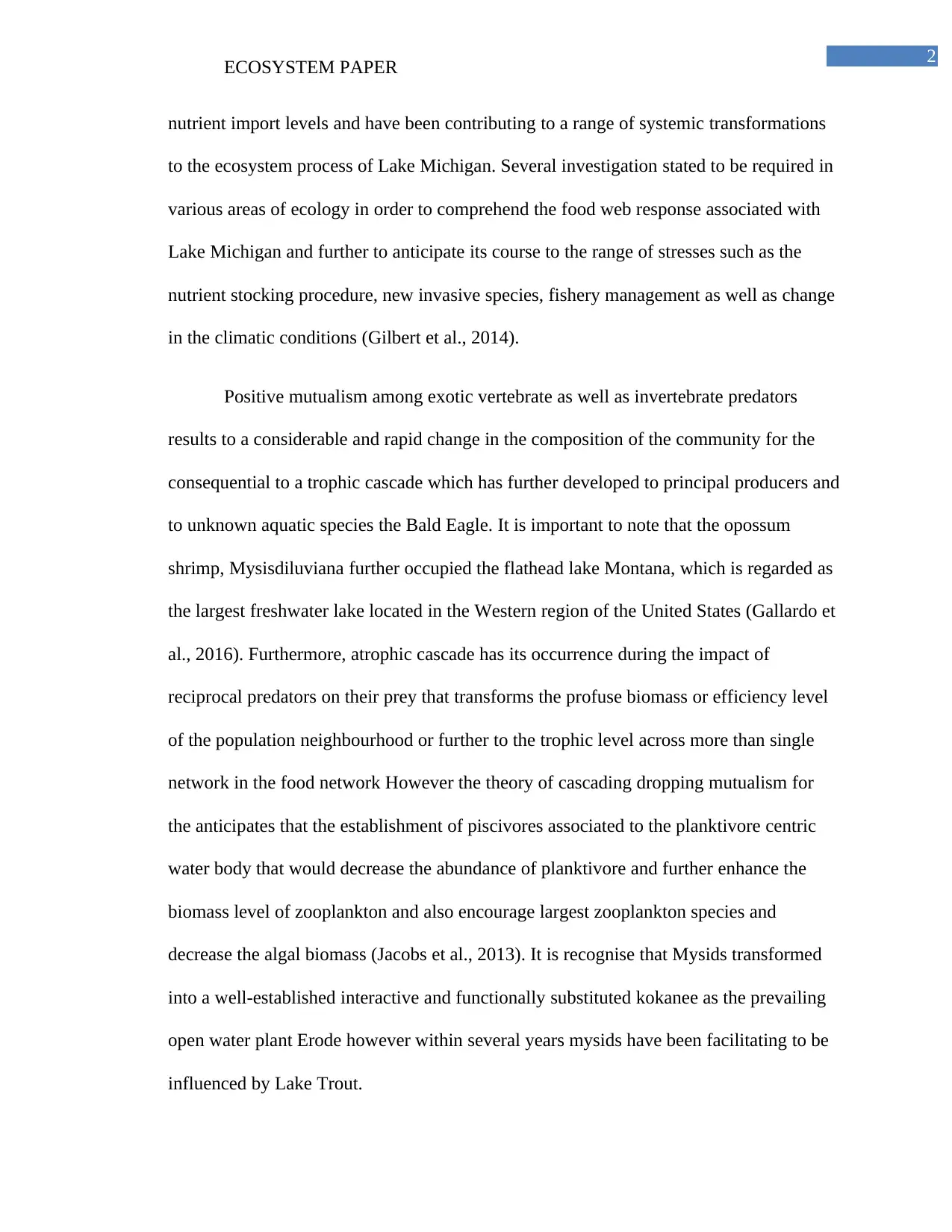
2
ECOSYSTEM PAPER
nutrient import levels and have been contributing to a range of systemic transformations
to the ecosystem process of Lake Michigan. Several investigation stated to be required in
various areas of ecology in order to comprehend the food web response associated with
Lake Michigan and further to anticipate its course to the range of stresses such as the
nutrient stocking procedure, new invasive species, fishery management as well as change
in the climatic conditions (Gilbert et al., 2014).
Positive mutualism among exotic vertebrate as well as invertebrate predators
results to a considerable and rapid change in the composition of the community for the
consequential to a trophic cascade which has further developed to principal producers and
to unknown aquatic species the Bald Eagle. It is important to note that the opossum
shrimp, Mysisdiluviana further occupied the flathead lake Montana, which is regarded as
the largest freshwater lake located in the Western region of the United States (Gallardo et
al., 2016). Furthermore, atrophic cascade has its occurrence during the impact of
reciprocal predators on their prey that transforms the profuse biomass or efficiency level
of the population neighbourhood or further to the trophic level across more than single
network in the food network However the theory of cascading dropping mutualism for
the anticipates that the establishment of piscivores associated to the planktivore centric
water body that would decrease the abundance of planktivore and further enhance the
biomass level of zooplankton and also encourage largest zooplankton species and
decrease the algal biomass (Jacobs et al., 2013). It is recognise that Mysids transformed
into a well-established interactive and functionally substituted kokanee as the prevailing
open water plant Erode however within several years mysids have been facilitating to be
influenced by Lake Trout.
ECOSYSTEM PAPER
nutrient import levels and have been contributing to a range of systemic transformations
to the ecosystem process of Lake Michigan. Several investigation stated to be required in
various areas of ecology in order to comprehend the food web response associated with
Lake Michigan and further to anticipate its course to the range of stresses such as the
nutrient stocking procedure, new invasive species, fishery management as well as change
in the climatic conditions (Gilbert et al., 2014).
Positive mutualism among exotic vertebrate as well as invertebrate predators
results to a considerable and rapid change in the composition of the community for the
consequential to a trophic cascade which has further developed to principal producers and
to unknown aquatic species the Bald Eagle. It is important to note that the opossum
shrimp, Mysisdiluviana further occupied the flathead lake Montana, which is regarded as
the largest freshwater lake located in the Western region of the United States (Gallardo et
al., 2016). Furthermore, atrophic cascade has its occurrence during the impact of
reciprocal predators on their prey that transforms the profuse biomass or efficiency level
of the population neighbourhood or further to the trophic level across more than single
network in the food network However the theory of cascading dropping mutualism for
the anticipates that the establishment of piscivores associated to the planktivore centric
water body that would decrease the abundance of planktivore and further enhance the
biomass level of zooplankton and also encourage largest zooplankton species and
decrease the algal biomass (Jacobs et al., 2013). It is recognise that Mysids transformed
into a well-established interactive and functionally substituted kokanee as the prevailing
open water plant Erode however within several years mysids have been facilitating to be
influenced by Lake Trout.
⊘ This is a preview!⊘
Do you want full access?
Subscribe today to unlock all pages.

Trusted by 1+ million students worldwide
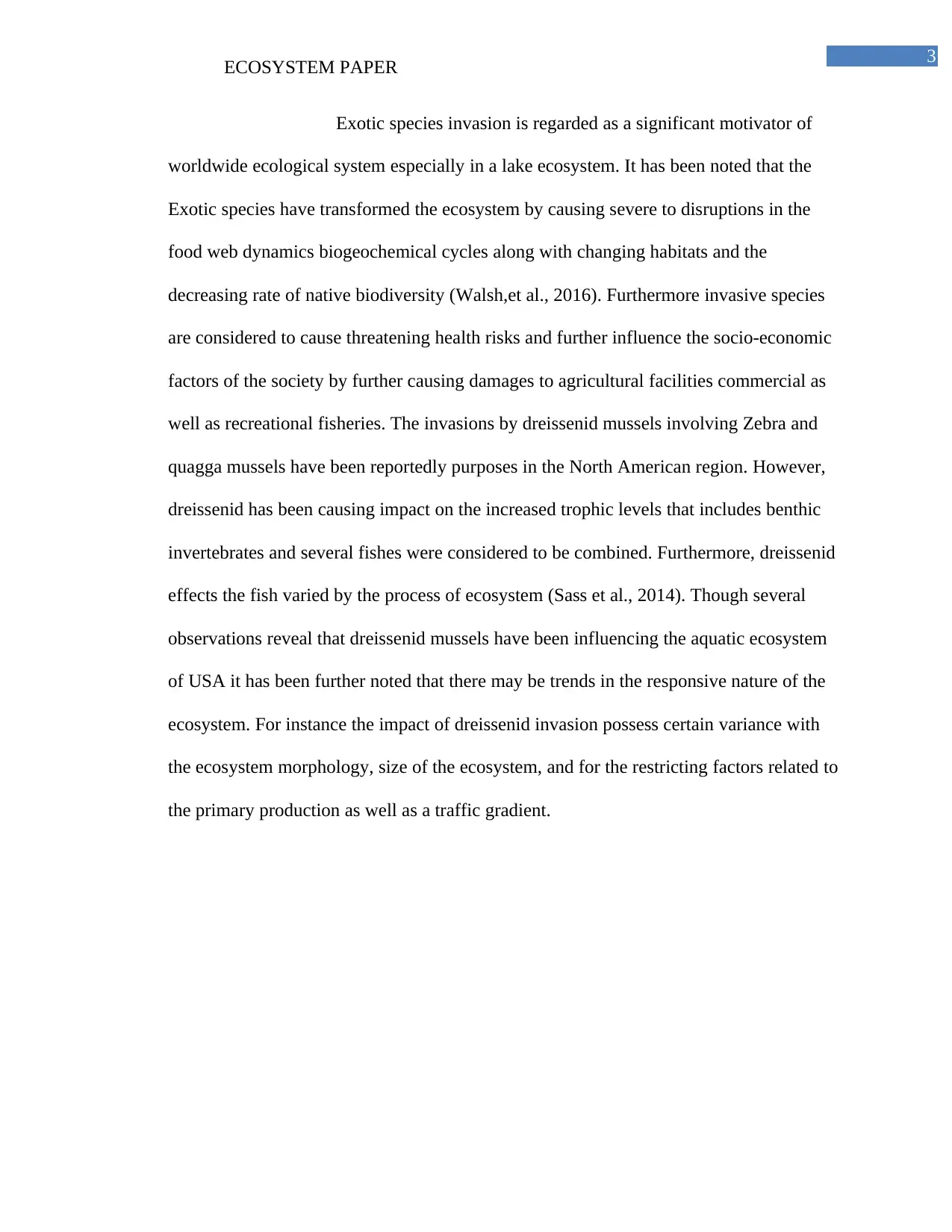
3
ECOSYSTEM PAPER
Exotic species invasion is regarded as a significant motivator of
worldwide ecological system especially in a lake ecosystem. It has been noted that the
Exotic species have transformed the ecosystem by causing severe to disruptions in the
food web dynamics biogeochemical cycles along with changing habitats and the
decreasing rate of native biodiversity (Walsh,et al., 2016). Furthermore invasive species
are considered to cause threatening health risks and further influence the socio-economic
factors of the society by further causing damages to agricultural facilities commercial as
well as recreational fisheries. The invasions by dreissenid mussels involving Zebra and
quagga mussels have been reportedly purposes in the North American region. However,
dreissenid has been causing impact on the increased trophic levels that includes benthic
invertebrates and several fishes were considered to be combined. Furthermore, dreissenid
effects the fish varied by the process of ecosystem (Sass et al., 2014). Though several
observations reveal that dreissenid mussels have been influencing the aquatic ecosystem
of USA it has been further noted that there may be trends in the responsive nature of the
ecosystem. For instance the impact of dreissenid invasion possess certain variance with
the ecosystem morphology, size of the ecosystem, and for the restricting factors related to
the primary production as well as a traffic gradient.
ECOSYSTEM PAPER
Exotic species invasion is regarded as a significant motivator of
worldwide ecological system especially in a lake ecosystem. It has been noted that the
Exotic species have transformed the ecosystem by causing severe to disruptions in the
food web dynamics biogeochemical cycles along with changing habitats and the
decreasing rate of native biodiversity (Walsh,et al., 2016). Furthermore invasive species
are considered to cause threatening health risks and further influence the socio-economic
factors of the society by further causing damages to agricultural facilities commercial as
well as recreational fisheries. The invasions by dreissenid mussels involving Zebra and
quagga mussels have been reportedly purposes in the North American region. However,
dreissenid has been causing impact on the increased trophic levels that includes benthic
invertebrates and several fishes were considered to be combined. Furthermore, dreissenid
effects the fish varied by the process of ecosystem (Sass et al., 2014). Though several
observations reveal that dreissenid mussels have been influencing the aquatic ecosystem
of USA it has been further noted that there may be trends in the responsive nature of the
ecosystem. For instance the impact of dreissenid invasion possess certain variance with
the ecosystem morphology, size of the ecosystem, and for the restricting factors related to
the primary production as well as a traffic gradient.
Paraphrase This Document
Need a fresh take? Get an instant paraphrase of this document with our AI Paraphraser
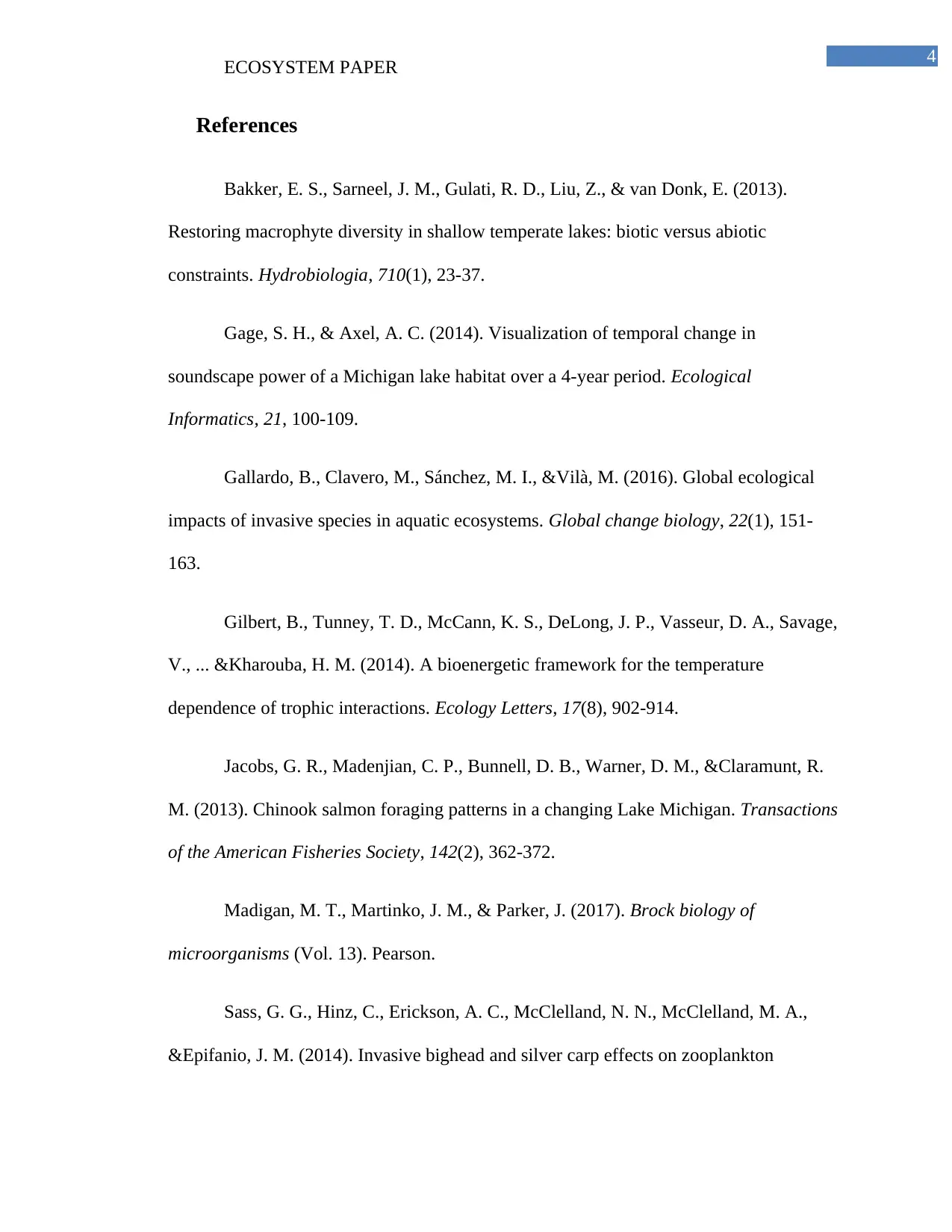
4
ECOSYSTEM PAPER
References
Bakker, E. S., Sarneel, J. M., Gulati, R. D., Liu, Z., & van Donk, E. (2013).
Restoring macrophyte diversity in shallow temperate lakes: biotic versus abiotic
constraints. Hydrobiologia, 710(1), 23-37.
Gage, S. H., & Axel, A. C. (2014). Visualization of temporal change in
soundscape power of a Michigan lake habitat over a 4-year period. Ecological
Informatics, 21, 100-109.
Gallardo, B., Clavero, M., Sánchez, M. I., &Vilà, M. (2016). Global ecological
impacts of invasive species in aquatic ecosystems. Global change biology, 22(1), 151-
163.
Gilbert, B., Tunney, T. D., McCann, K. S., DeLong, J. P., Vasseur, D. A., Savage,
V., ... &Kharouba, H. M. (2014). A bioenergetic framework for the temperature
dependence of trophic interactions. Ecology Letters, 17(8), 902-914.
Jacobs, G. R., Madenjian, C. P., Bunnell, D. B., Warner, D. M., &Claramunt, R.
M. (2013). Chinook salmon foraging patterns in a changing Lake Michigan. Transactions
of the American Fisheries Society, 142(2), 362-372.
Madigan, M. T., Martinko, J. M., & Parker, J. (2017). Brock biology of
microorganisms (Vol. 13). Pearson.
Sass, G. G., Hinz, C., Erickson, A. C., McClelland, N. N., McClelland, M. A.,
&Epifanio, J. M. (2014). Invasive bighead and silver carp effects on zooplankton
ECOSYSTEM PAPER
References
Bakker, E. S., Sarneel, J. M., Gulati, R. D., Liu, Z., & van Donk, E. (2013).
Restoring macrophyte diversity in shallow temperate lakes: biotic versus abiotic
constraints. Hydrobiologia, 710(1), 23-37.
Gage, S. H., & Axel, A. C. (2014). Visualization of temporal change in
soundscape power of a Michigan lake habitat over a 4-year period. Ecological
Informatics, 21, 100-109.
Gallardo, B., Clavero, M., Sánchez, M. I., &Vilà, M. (2016). Global ecological
impacts of invasive species in aquatic ecosystems. Global change biology, 22(1), 151-
163.
Gilbert, B., Tunney, T. D., McCann, K. S., DeLong, J. P., Vasseur, D. A., Savage,
V., ... &Kharouba, H. M. (2014). A bioenergetic framework for the temperature
dependence of trophic interactions. Ecology Letters, 17(8), 902-914.
Jacobs, G. R., Madenjian, C. P., Bunnell, D. B., Warner, D. M., &Claramunt, R.
M. (2013). Chinook salmon foraging patterns in a changing Lake Michigan. Transactions
of the American Fisheries Society, 142(2), 362-372.
Madigan, M. T., Martinko, J. M., & Parker, J. (2017). Brock biology of
microorganisms (Vol. 13). Pearson.
Sass, G. G., Hinz, C., Erickson, A. C., McClelland, N. N., McClelland, M. A.,
&Epifanio, J. M. (2014). Invasive bighead and silver carp effects on zooplankton
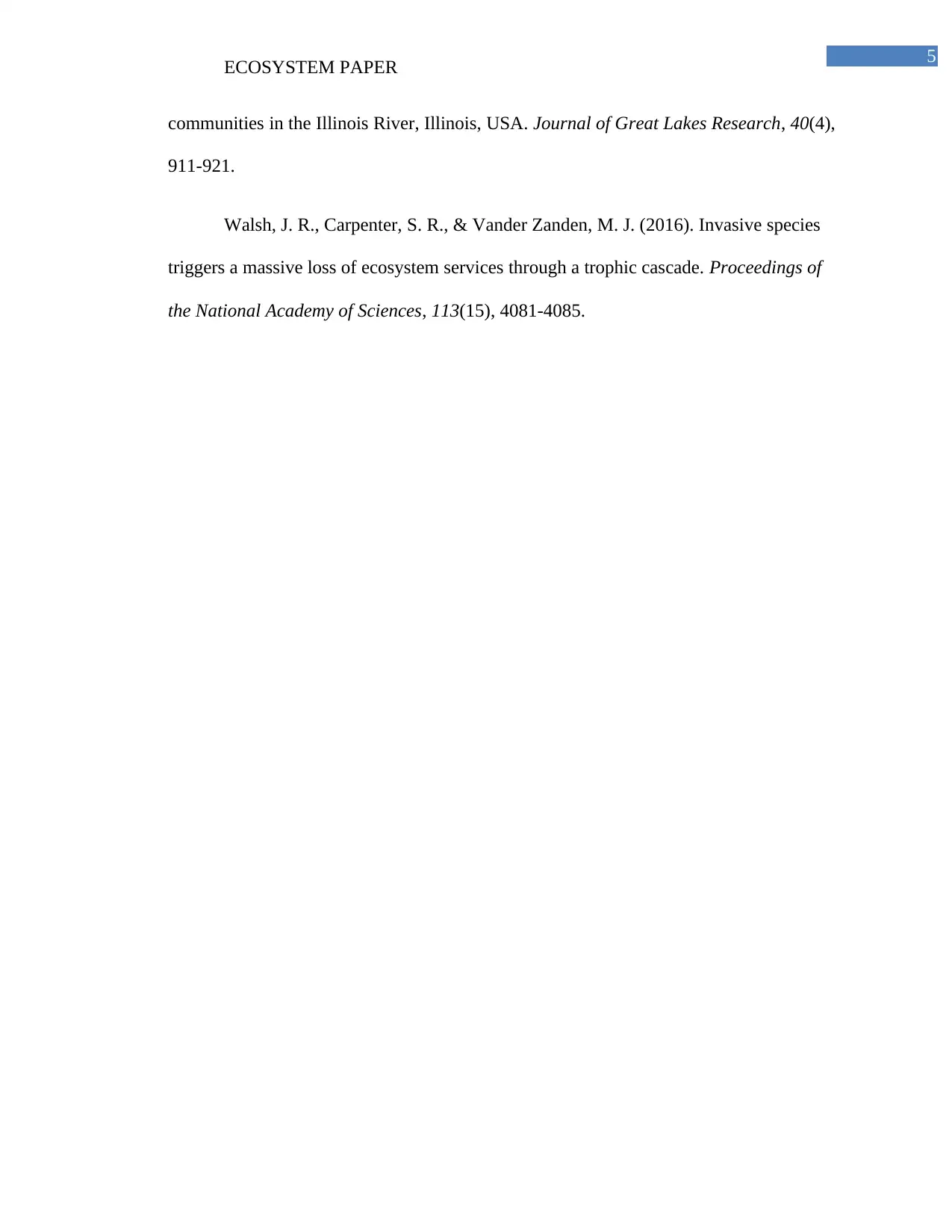
5
ECOSYSTEM PAPER
communities in the Illinois River, Illinois, USA. Journal of Great Lakes Research, 40(4),
911-921.
Walsh, J. R., Carpenter, S. R., & Vander Zanden, M. J. (2016). Invasive species
triggers a massive loss of ecosystem services through a trophic cascade. Proceedings of
the National Academy of Sciences, 113(15), 4081-4085.
ECOSYSTEM PAPER
communities in the Illinois River, Illinois, USA. Journal of Great Lakes Research, 40(4),
911-921.
Walsh, J. R., Carpenter, S. R., & Vander Zanden, M. J. (2016). Invasive species
triggers a massive loss of ecosystem services through a trophic cascade. Proceedings of
the National Academy of Sciences, 113(15), 4081-4085.
⊘ This is a preview!⊘
Do you want full access?
Subscribe today to unlock all pages.

Trusted by 1+ million students worldwide
1 out of 6
Your All-in-One AI-Powered Toolkit for Academic Success.
+13062052269
info@desklib.com
Available 24*7 on WhatsApp / Email
![[object Object]](/_next/static/media/star-bottom.7253800d.svg)
Unlock your academic potential
Copyright © 2020–2025 A2Z Services. All Rights Reserved. Developed and managed by ZUCOL.